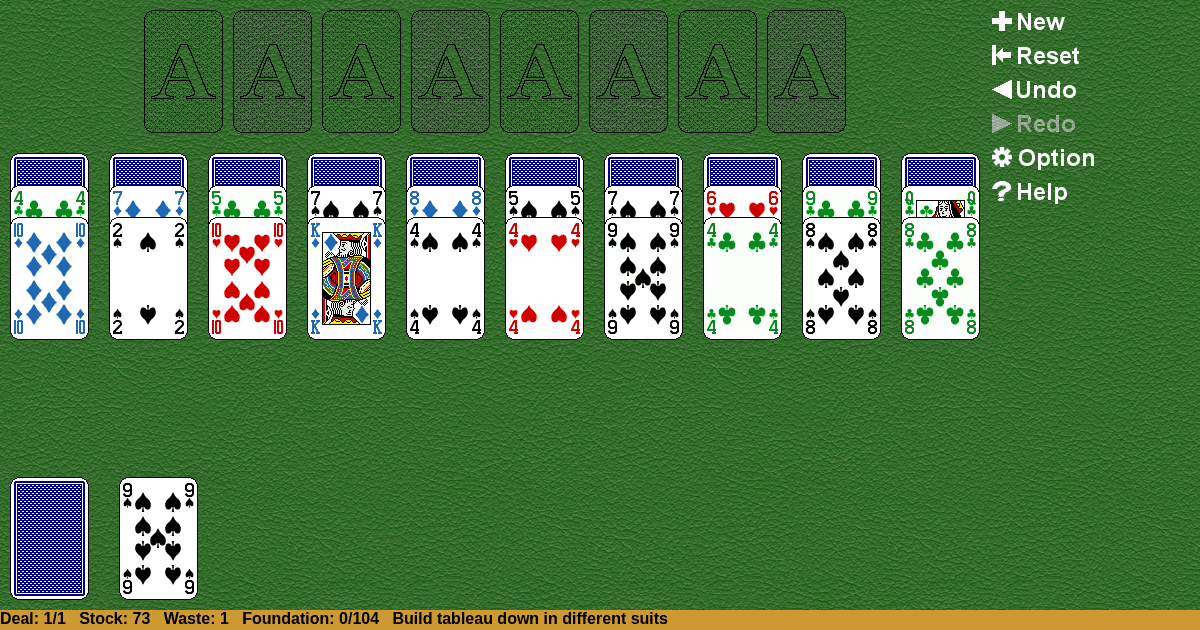Indian
Home |
How to play |
FAQ |
About
How to play Indian?
Game Objective:
The primary goal in Indian Solitaire is to move all cards from the tableau and stock to the eight foundation piles, building each foundation in ascending order by suit from Ace to King.
Setup & Layout:
- Deck: Use two standard 52-card decks (total 104 cards).
- Tableau: Deal ten piles (columns) with three cards each.
- In most versions, the bottom card is dealt face down, and the top two cards are dealt face up in each tableau pile.
- Some sources reverse this, dealing two cards face down and one face up. The prevailing rule is one face down, two face up per pile.
- Foundations: Eight empty foundation piles are placed above the tableau.
- Stock: The remaining cards form the stock (draw pile).
- Waste/Discard Pile: Cards drawn from the stock are placed here if not immediately playable.
- Key Play Areas:
- Tableau: Ten columns where cards are initially dealt and manipulated.
- Foundations: Eight piles built up by suit from Ace to King.
- Stock: The draw pile for additional cards.
- Waste/Discard Pile: Receives cards drawn from the stock not played to tableau or foundations.
Indian Solitaire Rules:
- Building on Foundations: Build up by suit, starting with Ace and ending with King.
- Tableau Building: Build down in rank, but not by suit—a card can be placed on any lower-ranked card of a different suit (e.g., 8♣ on 9♦, but not 9♣).
- Card Movement:
- Only the top card of each tableau pile or the top card of the waste pile is available for play.
- Move single cards only; sequences can be moved only one card at a time, unless empty tableau spaces are used strategically to transfer builds.
- Any available card (from tableau or waste) may be played to an empty tableau space.
- Revealing Cards: When a face-down card in the tableau becomes exposed (no cards above it), turn it face up.
- Stock/Waste Play: Cards are drawn one at a time from the stock to the waste pile. The top card of the waste pile is always available for play to the tableau or foundations.
- No Redeals: You may only pass through the stock once; after all cards are drawn, no redeal is permitted.
Gameplay:
- Typical Turn Sequence:
- Move available Aces to the foundations as soon as possible.
- Build tableau piles down in rank, placing cards only on lower-ranked cards of a different suit.
- Move cards to the foundations whenever possible.
- When no moves are available, draw a card from the stock to the waste pile; play it to the tableau or foundations if possible.
- Use empty tableau spaces to strategically reposition cards and facilitate further moves.
- Introducing New Cards:
- Cards are introduced into play from the stock, one at a time, to the waste pile.
- Only the top card of the waste pile is available for play.
- Stalemate:
- If no legal moves are possible and the stock is exhausted, the game ends.
Winning & Losing Conditions:
- Win Condition: The game is won when all 104 cards are successfully built onto the eight foundation piles, each in ascending order by suit from Ace to King.
- Lose/Unwinnable Condition: The game is lost or unwinnable if:
- The stock is exhausted and no more legal moves are possible.
- Not all cards can be moved to the foundations due to blocked sequences or inaccessible cards.
Special Rules & Edge Cases:
- Filling Empty Tableau Spaces: Any available card from the tableau or waste pile may be played to an empty tableau space.
- Sequence Movement: Only single cards may be moved at a time. However, if enough empty tableau spaces are available, you may transfer partial or full builds by moving them one card at a time.
- No Redeal: The stock is passed through only once; after all cards are drawn, play continues only with cards in the tableau and waste pile.
- Strategic Use of Empty Spaces: Empty tableau spaces are critical for maneuvering and freeing up blocked cards. Use them to temporarily hold cards and facilitate complex moves.
Definitions:
- Tableau: The main area of play, consisting of ten columns where cards are arranged and manipulated.
- Foundations: The target piles where cards are built up by suit from Ace to King.
- Stock: The draw pile for additional cards.
- Waste/Discard Pile: The pile where cards drawn from the stock are placed if not played immediately.
This guide covers the unique mechanics and ruleset for Indian Solitaire as supported by official and reputable sources.

Solitaire Collection
About Indian
Rate (Indian)
4.7 / 5
1,916 votes



























































